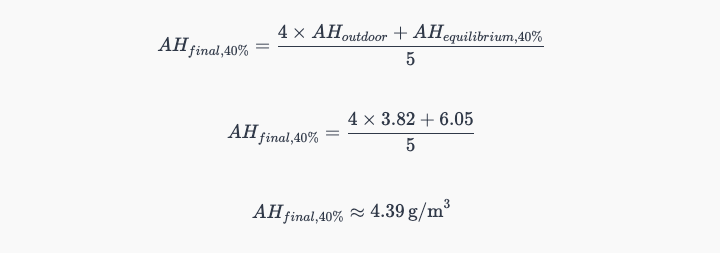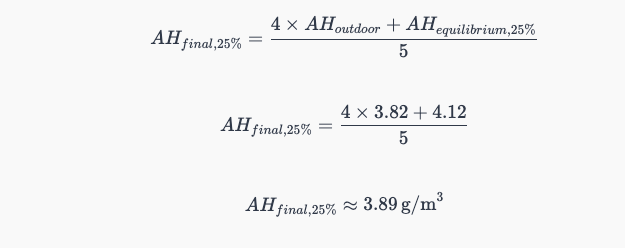✅ Humidity recovery cannot return more absolute humidity than the difference between indoor and outdoor air humidity allows.
(You can’t “create” humidity with recovery — only slow down its loss.)
✅ Ventilation systems with humidity recovery mainly help to retain indoor humidity longer if there are internal sources (people, cooking, plants, etc.).
✅ If there are no internal humidity sources, then over time, the indoor air will equilibrate to match the outdoor absolute humidity, even if humidity recovery is used.
✅ In that case, the final equilibrium humidity will be approximately the same as with a system without humidity recovery.
🔵 Humidity recovery only slows down the process, but cannot change the final outcome unless new moisture is continuously generated indoors.g here...
The Role of Humidity Recovery in Modern Ventilation Systems
In today's world, maintaining optimal indoor air quality is crucial for health, comfort, and energy efficiency. One of the key components in achieving this is humidity control. Humidity recovery systems play a vital role in modern ventilation systems, helping to retain indoor humidity levels and improve overall indoor air quality. This article explores the concept of humidity recovery, its benefits, and how it impacts both short-term and long-term indoor environments.
Understanding Humidity Recovery
Humidity recovery systems are designed to transfer moisture from the exhaust air to the incoming fresh air. This process helps to maintain indoor humidity levels, reducing the need for additional humidification or dehumidification. The efficiency of these systems can vary, but they typically recover a significant portion of the humidity that would otherwise be lost through ventilation.
Short-Term Benefits of Humidity Recovery
In the short term, humidity recovery systems provide immediate and noticeable impacts on indoor humidity levels. For example, on a cold winter day, a humidity recovery system can help keep the indoor air from becoming too dry too quickly. This improves occupant comfort and reduces the need for immediate humidification. The short-term benefits include:
- Immediate Comfort: Maintains comfortable humidity levels, preventing rapid changes that can cause discomfort.
- Energy Savings: Reduces the need for immediate heating, cooling, or humidification, leading to energy savings.
- Health and Well-being: Prevents immediate discomfort or health issues related to sudden changes in humidity.
Long-Term Benefits of Humidity Recovery
Over the long term, humidity recovery systems help in maintaining a more stable indoor environment. This reduces the overall energy required for heating, cooling, and humidification, leading to cost savings and improved sustainability. The long-term benefits include:
- Consistent Comfort: Achieves consistent comfort by reducing the frequency and severity of humidity fluctuations over extended periods.
- Energy Efficiency: Lower overall energy consumption due to more stable indoor conditions.
- Healthier Indoor Environment: Supports a healthier indoor environment by maintaining more consistent humidity levels.
- Reduced Maintenance Costs: Lower maintenance costs and extended lifespan of HVAC equipment due to reduced strain.
The Equilibrium of Indoor Humidity
It's important to note that humidity recovery systems cannot generate humidity; they can only transfer it. Therefore, the absolute humidity of the incoming air after recovery cannot exceed the humidity of the exhaust air or the outdoor air. If there are no indoor humidity sources, the indoor humidity will eventually approach the outdoor humidity level. However, humidity recovery systems can slow down this process, maintaining comfortable humidity levels for longer periods.
The Impact of Air Exchange Rate
The air exchange rate, which is the number of times the indoor air is replaced with outdoor air per hour, also plays a significant role. A higher air exchange rate will bring the indoor humidity closer to the outdoor humidity more quickly. However, a humidity recovery system can help retain more of the indoor humidity, slowing down this process.
For example, with an air exchange rate of 5 times per hour, the indoor humidity will approach the outdoor humidity more quickly. But with a humidity recovery efficiency of 70%, the system can still retain a significant portion of the indoor humidity, maintaining comfortable levels for longer.
Let's do some calculations
Let's calculate the benefits of humidity recovery:
- Outdoor Temperature: 0°C
- Outdoor Relative Humidity: 90%
- Indoor Temperature 20°C
- Starting Indoor Relative Humidity: 40% or 25%
- Outdoor Conditions:
Let's calculate Absolute Humidity (AH_outdoor): approximately 3.82 g/m³ 
where:
- TT is the temperature in °C.
- RHRH is the relative humidity in %.
For the outdoor conditions (0°C, 90% RH):

Let's use same calculation for indoors.
- Initial Absolute Humidity (AH_indoor, 40%): approximately 6.84 g/m³
- Initial Absolute Humidity (AH_indoor, 25%): approximately 4.27 g/m³
2. Indoor Conditions:
- Humidity Recovery Efficiency:
- Assume the humidity recovery efficiency is 70%.
- Air Exchange Rate:
- 5 times per hour means the entire volume of indoor air is replaced 5 times every hour.
Equilibrium Absolute Humidity:
The equilibrium absolute humidity indoors will be a balance between the outdoor humidity and the recovered humidity, considering the air exchange rate.
For 40% initial RH:

For 25% initial RH:

Effect of Air Exchange Rate:
With an air exchange rate of 5 times per hour, the indoor humidity will approach the outdoor humidity more quickly. However, the humidity recovery system will still retain some of the indoor humidity.
For simplicity, we can assume that the equilibrium humidity will be a weighted average of the outdoor humidity and the recovered indoor humidity, considering the air exchange rate.
For 40% initial RH:

For 25% initial RH:

Convert Back to Relative Humidity:
Finally, convert the final absolute humidity back to relative humidity using the indoor temperature (20°C).
For 40% initial RH:

For 25% initial RH:

Summary
- If the starting humidity value is 40%, the final indoor relative humidity will be approximately 32%.
- If the starting humidity value is 25%, the final indoor relative humidity will be approximately 28%.
Conclusion
Humidity recovery systems will not solve the humidity issue indoors in colder climates. To get indoor humidity solved, humidifiers have to be used. Humidity recovery can bring some short term relief but will also result in more service needs. While they cannot prevent the indoor humidity from eventually reaching equilibrium with the outdoor humidity, they can somewhat slow down this process, making them a crucial tool in maintaining optimal indoor air quality. At least of a same importance is ventilating only when the need arise thus not ventilating the humidity out.
Investing in a humidity recovery system shall be weighted decision considering immediate and long-term savings, added maintenance needs, improved comfort, and a healthier indoor environment.